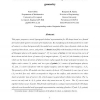972 search results - page 40 / 195 » Intersection types and computational effects |
CORR
2011
Springer
13 years 2 months ago
2011
Springer
good solutions to complex problems. In many examples, individuals trying to solve superior global solution. This suggests that there may be general principles of information aggre...
CVPR
2000
IEEE
14 years 9 months ago
2000
IEEE
This paper proposes a novel hypergraph skeletal representation for 3D shape based on a formal derivation of the generic structure of its medial axis. By classifying each skeletal ...
HPDC
1994
IEEE
13 years 11 months ago
1994
IEEE
Partitioning data parallel computations across a network of heterogeneous workstations is a dificult problem for the user: We have developed a runtime partitioning methodfor choos...
APL
1998
ACM
13 years 12 months ago
1998
ACM
This article describes how array predicates were used to reduce the computational complexity of four APL primitive functions when one of their arguments is a permutation vector. T...
DSN
2008
IEEE
14 years 2 months ago
2008
IEEE
Quorums are a basic construct in solving many fundamental distributed computing problems. One of the known ways of making quorums scalable and efficient is by weakening their int...

